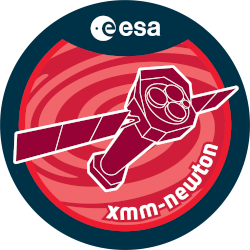

| Proposal ID | 011289 |
| Title | X-ray study of the supernova remnant G299.2-2.9 |
| Download Data Associated to the proposal | https://nxsa.esac.esa.int/nxsa-sl/servlet/data-action-aio?obsno=0112890101 |
| DOI | https://doi.org/10.5270/esa-xclgim5 |
| Principal Investigator, PI | Dr Bernd Aschenbach |
| Abstract | GT- G299.2-2.9 is a shell-type SNR of ~10 diameter discovered in the ROSATall-sky survey. It shows bright optical filaments and radio emission at 2.4 GHz.Both from the X-ray data and the radio data the distance cannot be determinedunambigously, but measurements of the column density and x-ray temperature andits distribution will help and clarify the age, for which we have just an upperlimit of 9.000 yrs. |
| Publications |
|
| Instrument | EMOS1, EMOS2, EPN, OM, RGS1, RGS2 |
| Temporal Coverage | 2002-02-24T07:28:54Z/2002-08-19T06:45:23Z |
| Version | 17.56_20190403_1200 |
| Mission Description | The European Space Agencys (ESA) X-ray Multi-Mirror Mission (XMM-Newton) was launched by an Ariane 504 on December 10th 1999. XMM-Newton is ESAs second cornerstone of the Horizon 2000 Science Programme. It carries 3 high throughput X-ray telescopes with an unprecedented effective area, and an optical monitor, the first flown on a X-ray observatory. The large collecting area and ability to make long uninterrupted exposures provide highly sensitive observations. Since Earths atmosphere blocks out all X-rays, only a telescope in space can detect and study celestial X-ray sources. The XMM-Newton mission is helping scientists to solve a number of cosmic mysteries, ranging from the enigmatic black holes to the origins of the Universe itself. Observing time on XMM-Newton is being made available to the scientific community, applying for observational periods on a competitive basis. |
| Creator Contact | https://www.cosmos.esa.int/web/xmm-newton/xmm-newton-helpdesk |
| Date Published | 2003-09-18T00:00:00Z |
| Last Update | 2025-01-27 |
| Keywords | "xray data", "supernova remnant g299", "radio emission", "column density", "ROSAT", "xray temperature", "G299.2", "x ray", "upper limit", "000 yrs", "bright optical filaments", "radio data", "sky survey" |
| Publisher And Registrant | European Space Agency |
| Credit Guidelines | European Space Agency, Dr Bernd Aschenbach, 2003, 'X-ray study of the supernova remnant G299.2-2.9', 17.56_20190403_1200, European Space Agency, https://doi.org/10.5270/esa-xclgim5 |